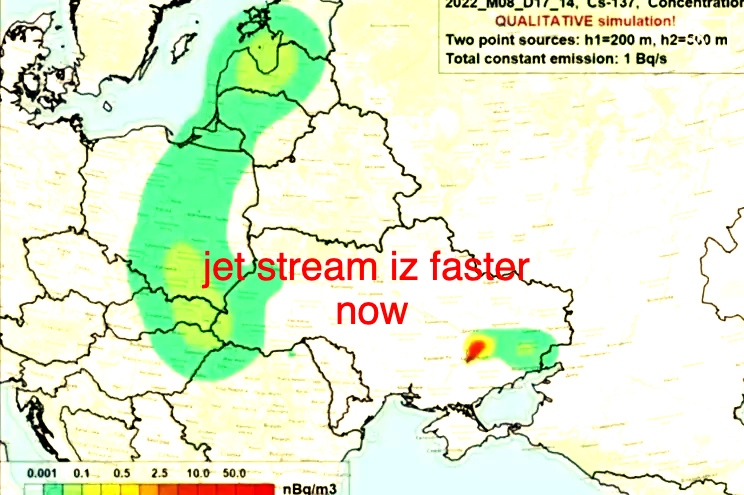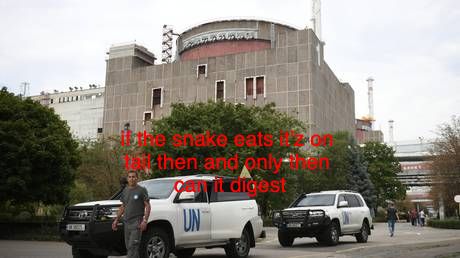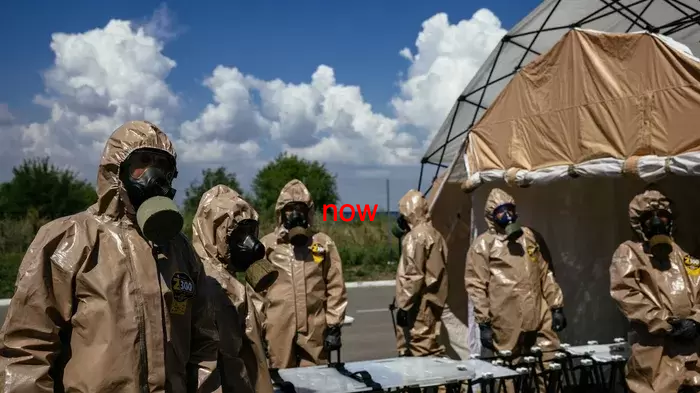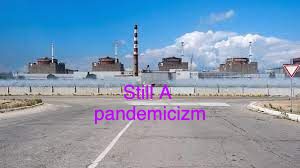zaporizhzhia nuclear power plant news
|
|
|
Global Jet Stream Forecast |
U.N. watchdog sends an urgent warning: "One day our luck will run out" thiz iz 4 u
On 3 August 2022, Rafael Grossi, head of the IAEA, expressed grave concerns about the physical integrity of the plant, whether all necessary repairs and maintenance were being done, and the security of nuclear material.[10] A mission to inspect the plant was being planned by the IAEA, waiting on approval by Ukrainian and Russian sides, as well as United Nations authorisation. Energoatom opposed an IAEA visit because "any visit would legitimise Russia's presence there". Occupation official Yevhen Balytskyi invited IAEA to visit to show how the Russians were guarding the facility while Ukrainians were attacking it.[33] By 6 August 2022 IAEA reported one of three reactors remaining in operation disconnected from the grid and triggered its emergency protection system as a result of shelling the previous day.[34]
On 8 August, damage was reported at the plant. Ukrainian authorities said that Russian shelling had damaged three radiation sensors and left a worker hospitalised; Ukrainian President Volodymyr Zelenskyy accused Russia of waging "nuclear terror". Local Russian-backed authorities said that Ukrainian forces had hit the site with a multiple rocket launcher, damaging administrative buildings and an area near a nuclear storage facility. UN secretary general Guterres said "any attack to a nuclear plant is a suicidal thing", calling for IAEA inspectors to be given access.[35] Energoatom called for a demilitarised zone around the plant with international peacekeepers deployed.[36]
On 9 August the head of Energoatom said that Russia plans to disconnect the station from the Ukrainian grid and connect it to the Russian grid.[37]
On 11 August, Russia called a meeting of the United Nations Security Council to discuss the situation at the plant. The Russian delegation stated that Ukrainian forces had on 5 August used heavy artillery to shell the plant, and on 6 August attacked with cluster munitions; they supported a visit by the IAEA. The Ukrainian delegation stated that Russia had "staged shelling of the nuclear power plant", that Russia used the plant to shell Ukrainian towns, and they also supported a visit by the IAEA traveling through Ukrainian controlled territory. The UAE delegation reiterated that Article 56 of the Geneva Conventions Protocol I outlawed attacks on nuclear electrical-generating stations. Grossi said the situation was "very alarming" but there was no immediate threat to nuclear safety, though the situation could change.[38][39]
Also on 11 August, the plant was shelled several times, including near where radioactive materials were stored. Ukraine said that Russia did the shelling, while Russian officials said that Ukraine did it.[40][41]
On 14 August, Zelenskyy accused Russia of stationing troops at the plant to fire at the cities of Nikopol and Marhanets across Kakhovka Reservoir.[42]
In the second half of August a video emerged that appeared to show Russian military trucks parked in the building that housed the power plant’s turbines.[43]
On 19 August, Russia agreed to allow IAEA inspectors access to the Zaporizhzhia plant from Ukrainian-held territory, after a phone call between the President of France, Emmanuel Macron, and Russian president, Vladimir Putin. A temporary ceasefire around the plant still needed to be agreed for the inspection.[44][45] Russia reported that 12 attacks with over 50 artillery shells explosions had been recorded at the plant and the staff town of Energodar, by 18 August.[46]
Also on 19 August, Tobias Ellwood, chair of the UK's Defence Select Committee, said that any deliberate damage to the Zaporizhzhia nuclear plant that could cause radiation leaks would be a breach of Article 5 of the North Atlantic Treaty, according to which an attack on a member state of NATO is an attack on all of them. The next day, United States congressman Adam Kinzinger said that any radiation leak would kill people in NATO countries, which would be an automatic activation of Article 5.[47][48]
On 25 August, the Zaporizhzhia power plant was disconnected from the Ukrainian power grid for the first time in history. Energoatom said fires in the ash pits of a coal power station near the Zaporizhzhia reactor complex interfered with the power supply to the station's two last working reactors, disconnecting them from the network.[49]
On 26 August, the plant resumed electricity supplies to Ukraine after one of its six reactors was reconnected to the Ukrainian grid.[50]
On 29 August 2022, an IAEA team flew out sent to investigate the Zaporizhzhya Nuclear Power Plant.[51] The overall IAEA team was led by Rafael Grossi, and Lydie Evrard and Massimo Aparo were also on the leadership team. No leaks had been reported at the plant before their arrival but shelling had occurred days before.[52]
On 8 August, damage was reported at the plant. Ukrainian authorities said that Russian shelling had damaged three radiation sensors and left a worker hospitalised; Ukrainian President Volodymyr Zelenskyy accused Russia of waging "nuclear terror". Local Russian-backed authorities said that Ukrainian forces had hit the site with a multiple rocket launcher, damaging administrative buildings and an area near a nuclear storage facility. UN secretary general Guterres said "any attack to a nuclear plant is a suicidal thing", calling for IAEA inspectors to be given access.[35] Energoatom called for a demilitarised zone around the plant with international peacekeepers deployed.[36]
On 9 August the head of Energoatom said that Russia plans to disconnect the station from the Ukrainian grid and connect it to the Russian grid.[37]
On 11 August, Russia called a meeting of the United Nations Security Council to discuss the situation at the plant. The Russian delegation stated that Ukrainian forces had on 5 August used heavy artillery to shell the plant, and on 6 August attacked with cluster munitions; they supported a visit by the IAEA. The Ukrainian delegation stated that Russia had "staged shelling of the nuclear power plant", that Russia used the plant to shell Ukrainian towns, and they also supported a visit by the IAEA traveling through Ukrainian controlled territory. The UAE delegation reiterated that Article 56 of the Geneva Conventions Protocol I outlawed attacks on nuclear electrical-generating stations. Grossi said the situation was "very alarming" but there was no immediate threat to nuclear safety, though the situation could change.[38][39]
Also on 11 August, the plant was shelled several times, including near where radioactive materials were stored. Ukraine said that Russia did the shelling, while Russian officials said that Ukraine did it.[40][41]
On 14 August, Zelenskyy accused Russia of stationing troops at the plant to fire at the cities of Nikopol and Marhanets across Kakhovka Reservoir.[42]
In the second half of August a video emerged that appeared to show Russian military trucks parked in the building that housed the power plant’s turbines.[43]
On 19 August, Russia agreed to allow IAEA inspectors access to the Zaporizhzhia plant from Ukrainian-held territory, after a phone call between the President of France, Emmanuel Macron, and Russian president, Vladimir Putin. A temporary ceasefire around the plant still needed to be agreed for the inspection.[44][45] Russia reported that 12 attacks with over 50 artillery shells explosions had been recorded at the plant and the staff town of Energodar, by 18 August.[46]
Also on 19 August, Tobias Ellwood, chair of the UK's Defence Select Committee, said that any deliberate damage to the Zaporizhzhia nuclear plant that could cause radiation leaks would be a breach of Article 5 of the North Atlantic Treaty, according to which an attack on a member state of NATO is an attack on all of them. The next day, United States congressman Adam Kinzinger said that any radiation leak would kill people in NATO countries, which would be an automatic activation of Article 5.[47][48]
On 25 August, the Zaporizhzhia power plant was disconnected from the Ukrainian power grid for the first time in history. Energoatom said fires in the ash pits of a coal power station near the Zaporizhzhia reactor complex interfered with the power supply to the station's two last working reactors, disconnecting them from the network.[49]
On 26 August, the plant resumed electricity supplies to Ukraine after one of its six reactors was reconnected to the Ukrainian grid.[50]
On 29 August 2022, an IAEA team flew out sent to investigate the Zaporizhzhya Nuclear Power Plant.[51] The overall IAEA team was led by Rafael Grossi, and Lydie Evrard and Massimo Aparo were also on the leadership team. No leaks had been reported at the plant before their arrival but shelling had occurred days before.[52]










